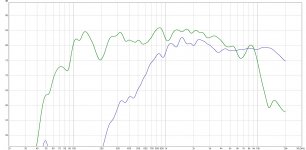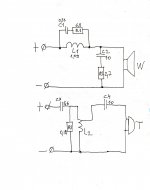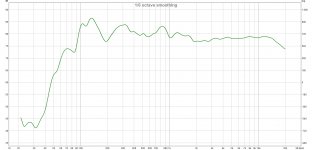What concerns me more about the response is the room modes below 400Hz. Without seeing the wider response it is unclear that the crossover is really a problem.
However, your crossover does offer options for increasing the treble, even though it doesn't have resistors. A lack of resistors isn't the problem, simming it is your current challenge. - XSim free crossover designer
However, your crossover does offer options for increasing the treble, even though it doesn't have resistors. A lack of resistors isn't the problem, simming it is your current challenge. - XSim free crossover designer
However, your crossover does offer options for increasing the treble
What options?
It is the raw response
Attachments
If the resistor is 0.18 ohms, permit me to take a step back and clarify, for the safety for the amp. For the response measurement you should remove the resistor. It has no effect here other than to overload the amp.
This has become much more complicated than I wanted to make it, so I now want to ask you what you are doing, why are you simming this in Xsim.. so I don't make redundant conversation.
P.S. That's a very small value of resistor.
This has become much more complicated than I wanted to make it, so I now want to ask you what you are doing, why are you simming this in Xsim.. so I don't make redundant conversation.
P.S. That's a very small value of resistor.
why are you simming this in Xsim
Just want to see what can I do with Tannoy MX2 crossover (or opposite).
First impressions tell me that there's no sense in any serious changes. The only thing i want to improve now is sound balance. Tweeter is less sensitive than woofer and i want to fix it.
The most simple way to fix it is to use LPad. Say 1.5/10 Ohms. What consequences will be in that case in real usage scenario?
Last edited:
Hey akarma. If that resistor is really 0.18 ohms then increasing it will increase your treble.
I'd estimate it is pulling the treble down 30dB.
I'd estimate it is pulling the treble down 30dB.
If that resistor is really 0.18 ohms then increasing it will increase your treble.
I need to remeasure the value of resistor. May be I have mistaken. But in any case tweeter's raw response is lower than woofer
You should be able to get an increase in the approximately 1-6kHz region by increasing the value of one or both of the capacitors.
This speaker has a problem in the mid frequencies that needs to be addressed and can be really annoying.
^ That doesn't sound good.
The raw responses, plus overlap, should be enough to give the kind of response I'd expect especially considering a tonal tilt and baffle effects.
Could you get some 1-2uF capacitors and start clipping them on to the existing two capacitors to get a feel for it?
The raw responses, plus overlap, should be enough to give the kind of response I'd expect especially considering a tonal tilt and baffle effects.
Could you get some 1-2uF capacitors and start clipping them on to the existing two capacitors to get a feel for it?
This is all a bit of a waste of time without knowing the crossover schematic.
I did find some pictures from a Tannoy MX2, and it looks like a 2.7R/18R attenuator on the tweeter.
Matched pair of crossovers from Tannoy MX2 vg working order with biwire links | eBay
Looks like a 0.33uF tank notch on the 6" paper woofer to take out some breakup energy around 5kHz too.
Regardless of exact detail, your plan for a louder tweeter will be to use a smaller attenuator, or reduce the resistances.
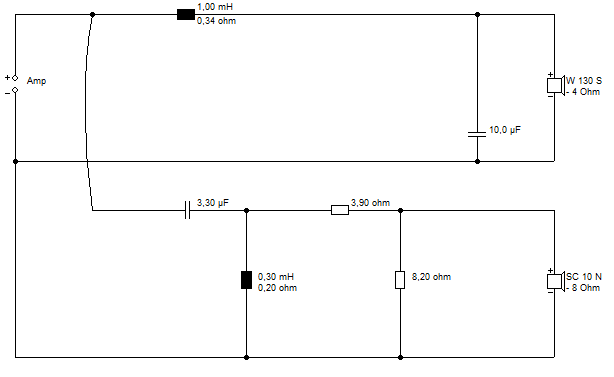
These things are all much the same. You generally reduce a 90dB tweeter's level to match an 85-87dB woofer. But really, you should draw the circuit. 1R change in series resistance changes level by 1dB. 3dB is double the power level, so significant.
So you might be looking at removing the 18R, and changing the 2.7R to 1.5R. Ought to be 2dB louder.
I did find some pictures from a Tannoy MX2, and it looks like a 2.7R/18R attenuator on the tweeter.
Matched pair of crossovers from Tannoy MX2 vg working order with biwire links | eBay
Looks like a 0.33uF tank notch on the 6" paper woofer to take out some breakup energy around 5kHz too.
Regardless of exact detail, your plan for a louder tweeter will be to use a smaller attenuator, or reduce the resistances.
These things are all much the same. You generally reduce a 90dB tweeter's level to match an 85-87dB woofer. But really, you should draw the circuit. 1R change in series resistance changes level by 1dB. 3dB is double the power level, so significant.
So you might be looking at removing the 18R, and changing the 2.7R to 1.5R. Ought to be 2dB louder.
Thanks for help all of you.
This is Tannoy Mercury MX2 crossover. May be it will be useful for someone
This is all a bit of a waste of time without knowing the crossover schematic.
This is Tannoy Mercury MX2 crossover. May be it will be useful for someone
Attachments
I tweaked crossover a little bit. Changed R3 and added LPad to midwoofer (1/20 Ohms). This is my new response
Sounds good to my taste. It works in HT setup with Denon 1500, Tannoy MXR, Tannoy MXC and sub.
The sound is on mellow side but i like it.
Sounds good to my taste. It works in HT setup with Denon 1500, Tannoy MXR, Tannoy MXC and sub.
The sound is on mellow side but i like it.
Attachments
Afternoon, Allen.
This image looks troublesome big. So here's the small version.
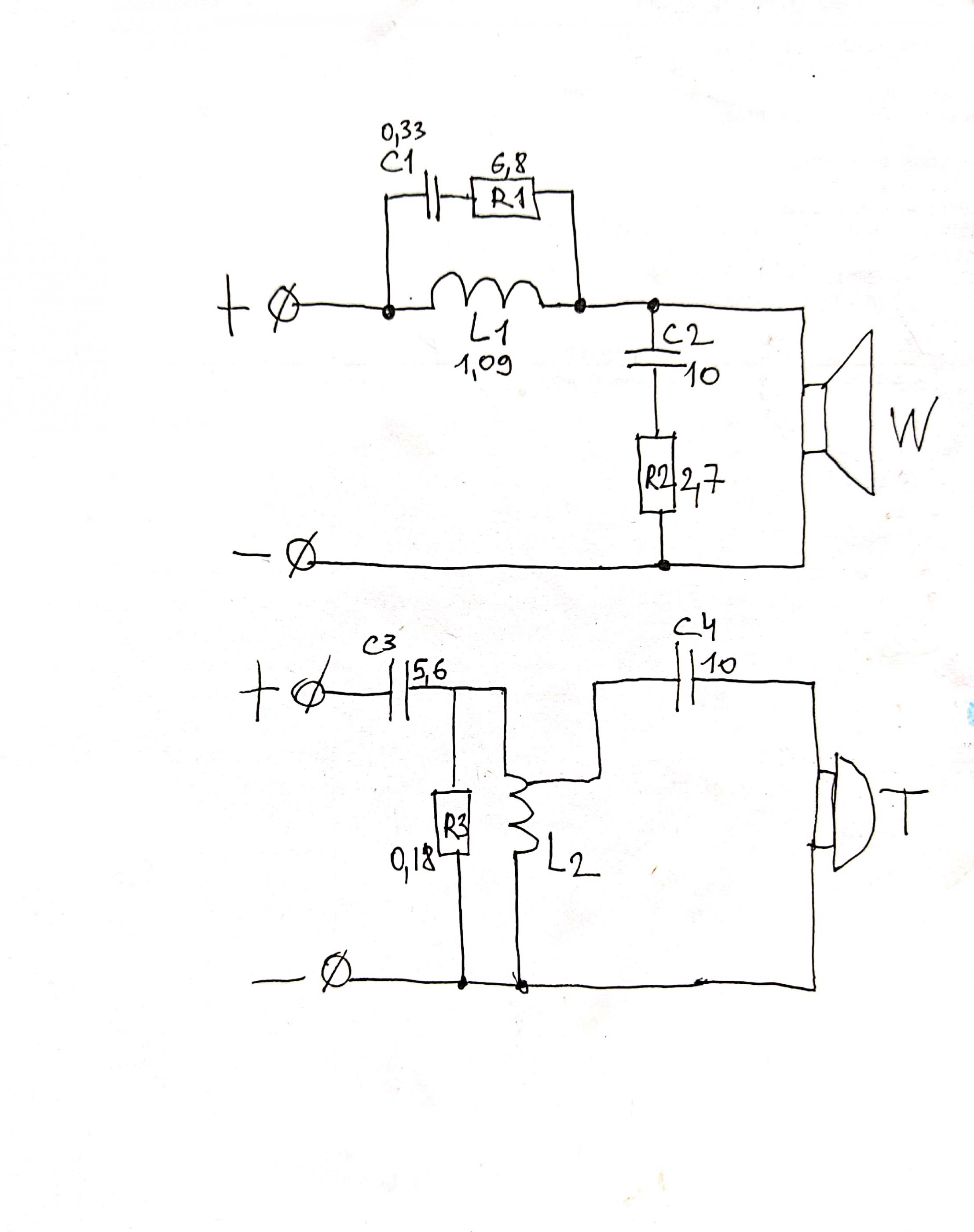
But that resistor across the tweeter coil is an attenuator. Can't be 0.18R though. That would be almost a short. Heybrook used that style in the HB2 IIRC. The 15R.
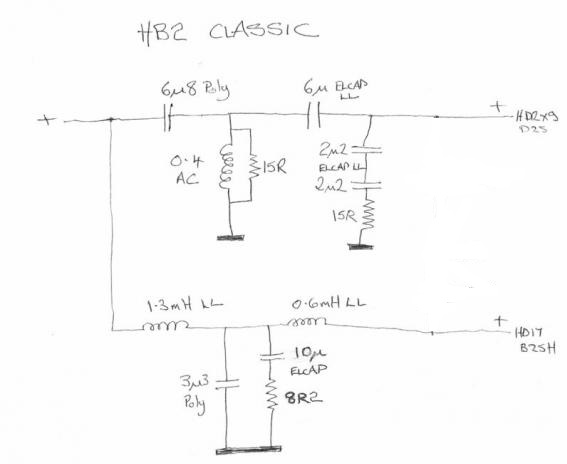
I think you just remove it.
This image looks troublesome big. So here's the small version.
But that resistor across the tweeter coil is an attenuator. Can't be 0.18R though. That would be almost a short. Heybrook used that style in the HB2 IIRC. The 15R.
I think you just remove it.
It's a thoughtful design.
https://www.diyaudio.com/forums/software-tools/259865-xsim-free-crossover-designer-89.html#post6363336
Better than most. 6" paper bass is quite a hard speaker, IMO. Looks bass light to me with that smallish bass coil. . Probably works best close to a wall.
https://www.diyaudio.com/forums/software-tools/259865-xsim-free-crossover-designer-89.html#post6363336
Better than most. 6" paper bass is quite a hard speaker, IMO. Looks bass light to me with that smallish bass coil. . Probably works best close to a wall.
Looks bass light to me with that smallish bass coil. . Probably works best close to a wall
Agree. The best choice is to use with subwoofer
Just crossed my mind that you wanted to attenuate the woofer originally.
It's not something that is usually very practical. But there is a recognised trick on this:
Seas ER18RNX with 27TDFC
Since you are biwireable, it wouldn't be hard to add a coil and a resistor to the bass section.
From outside the speaker. This is called passive bafflestep. The bass level is unaffected, but the midrange from the bass drops. Might be just what you are looking for. If youve got, say, some 1mH coils and a couple of 3R3 to 4R7 (10W) resistors lying about, you could probably get this running in about half an hour.
Me old mate Michael Chua says it has "buttery smoothness". Sounds promising to me. 😀
It's not something that is usually very practical. But there is a recognised trick on this:
Seas ER18RNX with 27TDFC
Since you are biwireable, it wouldn't be hard to add a coil and a resistor to the bass section.
From outside the speaker. This is called passive bafflestep. The bass level is unaffected, but the midrange from the bass drops. Might be just what you are looking for. If youve got, say, some 1mH coils and a couple of 3R3 to 4R7 (10W) resistors lying about, you could probably get this running in about half an hour.
Me old mate Michael Chua says it has "buttery smoothness". Sounds promising to me. 😀
- Home
- Loudspeakers
- Multi-Way
- Midwoofer's attenuation

